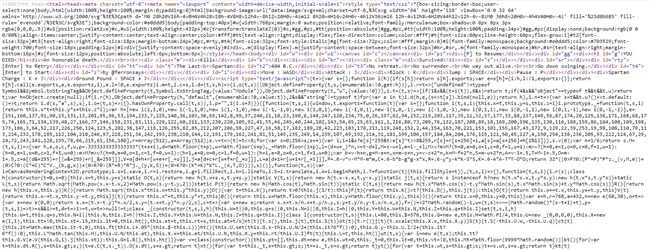Ingenious games in just 13KB of JavaScript
 I’m not fond of JavaScript but I am still in awe at the ingenuity of people who created a HTML5 game in JavaScript in just 13KB. There’s an annual competition called Js13K and this year there were 220 entries and prizes of $20,000 in total.
I’m not fond of JavaScript but I am still in awe at the ingenuity of people who created a HTML5 game in JavaScript in just 13KB. There’s an annual competition called Js13K and this year there were 220 entries and prizes of $20,000 in total.
When you think that many graphics are way bigger than 13KB this is even more of an accomplishment. It means those games have to mostly draw their own. graphics rather than use prerendered graphical images. It helps that HTML5 includes a canvas drawing area and instructions in JavaScript to draw into it.
The GitHub Blog featured the top ten from this years competition. The picture comes from The Last Spartan which I really liked. Ironically the screen grab image was 121KB, almost eight x the size of the actual game!
If you are ever stuck for ideas for games, take a look at these. Being JavaScript, you can right-click in your browser and View Source (Chrome) or View Page Source (Firefox). Of course, to achieve 13KB, many of them have been minified which means getting rid of all spaces, carriage returns and renders it rather unreadable. This is what it looks like.

However the internet taketh and the internet giveth. If you paste this (or any of the source listings) into an online deminifier (aka beautifier) such as beautifier.io then you get all 1622 lines laid out in immaculately indented glory. It’s actually 73KB in size as a normal listing and still very impressive.
There’s no reason why games can’t be done this way i.e. drawing graphics in C+SDL2 though I doubt I’d get them down to 13KB. My asteroids game which was 2200 lines of C generates a 96 KB exe. But when you add in images, SDL code and sounds etc it comes out at just under 35 MB.




 This is somewhat off-topic and a little bit of self-indulgence because (a) it’s about a computer that existed over 36 years ago and (b) a game that was programmed in 6502 assembler. It’s also a game I played a lot back in 1984.
This is somewhat off-topic and a little bit of self-indulgence because (a) it’s about a computer that existed over 36 years ago and (b) a game that was programmed in 6502 assembler. It’s also a game I played a lot back in 1984. A developer called Michael Gerdes just published a
A developer called Michael Gerdes just published a  Oh I do play much newer games such as Far Cry 5 which I’ve completed recently but Quake II was a favourite of mine back in 1997 when I bought it. I’m more of a Quake than a Doom person. Unfortunately for me, my then PC couldn’t run it. It was only two years old as well. But I got a new PC in 1998 and that played it just fine. I’m not saying I’m a saddo but I can play it through on the hardest level without losing a life.
Oh I do play much newer games such as Far Cry 5 which I’ve completed recently but Quake II was a favourite of mine back in 1997 when I bought it. I’m more of a Quake than a Doom person. Unfortunately for me, my then PC couldn’t run it. It was only two years old as well. But I got a new PC in 1998 and that played it just fine. I’m not saying I’m a saddo but I can play it through on the hardest level without losing a life. I occasionally answer (often in a somewhat ascerbic tone) questions on
I occasionally answer (often in a somewhat ascerbic tone) questions on  I noticed that the Covid lockdown had made streaming of chess games very popular and did a search to see if I could find the source of one in C. The first one I found was actually C++ (cout << is a bit of a giveaway!) but I found this one by a developer called
I noticed that the Covid lockdown had made streaming of chess games very popular and did a search to see if I could find the source of one in C. The first one I found was actually C++ (cout << is a bit of a giveaway!) but I found this one by a developer called 